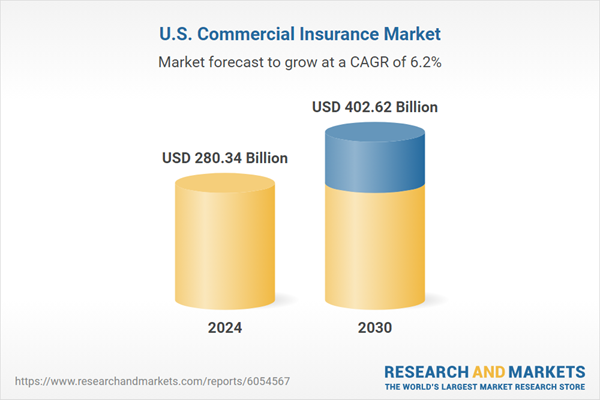Speak directly to the analyst to clarify any post sales queries you may have.
10% Free customizationThis report comes with 10% free customization, enabling you to add data that meets your specific business needs.
Key Market Drivers
Regulatory and Compliance Requirements
The U.S. commercial insurance market is heavily influenced by federal and state-level regulations that govern coverage mandates, capital requirements, and consumer protection laws. Regulatory bodies such as the National Association of Insurance Commissioners (NAIC) and state insurance departments enforce solvency requirements and rate approvals, ensuring market stability. The Affordable Care Act (ACA), Workers' Compensation laws, and the Terrorism Risk Insurance Program Reauthorization Act (TRIPRA) also impact policy structures and pricing.Increasing compliance requirements related to cyber risk, data privacy (such as the California Consumer Privacy Act), and environmental liabilities are prompting insurers to develop new products. Additionally, the introduction of risk-based capital (RBC) frameworks and evolving reinsurance regulations influence capital allocation and underwriting strategies. Stricter reporting and disclosure requirements, such as the NAIC’s Climate Risk Disclosure, are pushing insurers to assess climate-related risks more thoroughly. The regulatory landscape continues to evolve, with increased scrutiny on premium pricing transparency and the use of AI in underwriting, shaping the future of commercial insurance in the U.S.
Key Market Challenges
Rising Claims Costs and Loss Ratios
One of the most significant challenges in the U.S. commercial insurance market is the escalating cost of claims, which directly impacts insurers’ profitability and loss ratios. Inflation, supply chain disruptions, and increased litigation expenses have driven up claims severity across multiple lines of business, particularly in property, commercial auto, and liability insurance. The rising cost of construction materials and labor has led to higher payouts for property damage claims, while the surge in medical costs has inflated workers’ compensation and liability claims. Additionally, the frequency of catastrophic weather events, including hurricanes, wildfires, and floods, has increased, leading to higher insured losses.In 2023 alone, the U.S. experienced 28 billion-dollar weather and climate disasters, exacerbating financial pressures on insurers. Social inflation - driven by rising litigation costs, nuclear verdicts, and evolving legal frameworks - has also led to larger settlements and higher premiums for policyholders. The commercial auto segment, in particular, has been heavily affected by increasing accident severity, repair costs, and legal judgments, making profitability a challenge. To mitigate these rising costs, insurers are adjusting underwriting criteria, increasing premiums, and exploring advanced analytics to improve claims management and risk assessment.
Key Market Trends
Expansion of Cyber Insurance and Risk Management Solutions
With the increasing frequency and sophistication of cyberattacks, cyber insurance has become one of the fastest-growing segments in the U.S. commercial insurance market. Businesses across industries face rising threats from ransomware, data breaches, and phishing schemes, driving demand for comprehensive cyber liability policies. In 2023, the average cost of a data breach in the U.S. reached USD 9.48 million, underscoring the financial risks associated with cybersecurity incidents. Insurers areKey Market Players
- Allianz SE
- American International Group Inc.
- Aon plc
- Aviva plc
- Axa S.A.
- Chubb Group Holdings Inc.
- Direct Line Insurance Group plc
- Marsh & McLennan Companies Inc.
- Willis Towers Watson Public Limited Company
- Zurich Insurance Group Ltd.
Report Scope:
In this report, the United States Commercial Insurance Market has been segmented into the following categories, in addition to the industry trends which have also been detailed below:United States Commercial Insurance Market, By Type:
- Liability Insurance
- Commercial Motor Insurance
- Commercial Property Insurance
- Marine Insurance
- Others
United States Commercial Insurance Market, By Sales Channel:
- Agents
- Brokers
- Direct
- Others
United States Commercial Insurance Market, By Industry:
- Manufacturing
- Construction
- IT & Telecom
- Healthcare
- Transportation
- Others
United States Commercial Insurance Market, By Region:
- South
- West
- Midwest
- Northeast
Competitive Landscape
Company Profiles: Detailed analysis of the major companies present in the United States Commercial Insurance Market.Available Customizations:
With the given market data, the publisher offers customizations according to a company's specific needs. The following customization options are available for the report.Company Information
- Detailed analysis and profiling of additional market players (up to five).
This product will be delivered within 1-3 business days.
Table of Contents
Companies Mentioned
- Allianz SE
- American International Group Inc.
- Aon plc
- Aviva plc
- Axa S.A.
- Chubb Group Holdings Inc.
- Direct Line Insurance Group plc
- Marsh & McLennan Companies Inc.
- Willis Towers Watson Public Limited Company
- Zurich Insurance Group Ltd.
Table Information
| Report Attribute | Details |
|---|---|
| No. of Pages | 84 |
| Published | February 2025 |
| Forecast Period | 2024 - 2030 |
| Estimated Market Value ( USD | $ 280.34 Billion |
| Forecasted Market Value ( USD | $ 402.62 Billion |
| Compound Annual Growth Rate | 6.2% |
| Regions Covered | United States |
| No. of Companies Mentioned | 10 |









